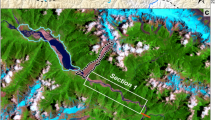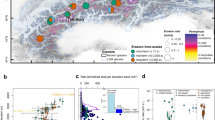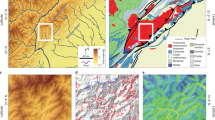Abstract
The steep topography of mountain landscapes arises from interactions among tectonic rock uplift, valley incision and landslide erosion on hillslopes. Hillslopes in rapidly uplifting landscapes are thought to respond to river incision into bedrock by steepening to a maximum stable or ‘threshold’ angle1,2,3. Landslide erosion rates are predicted to increase nonlinearly as hillslope angles approach the threshold angle1,2,3,4,5,6,7. However, the key tenet of this emerging threshold hillslope model of landscape evolution—the coupled response of landslide erosion to tectonic and fluvial forcing—remains untested. Here we quantify landslide erosion rates in the eastern Himalaya, based on mapping more than 15,000 landslides on satellite images. We show that landslide erosion rates are significantly correlated with exhumation rates and stream power and that small increases in mean hillslope angles beyond 30° translate into large and significant increases in landslide erosion. Extensive landsliding in response to a large outburst flood indicates that lateral river erosion is a key driver of landslide erosion on threshold hillslopes. Our results confirm the existence of threshold hillslopes and demonstrate that an increase in landslide erosion rates, rather than steepened hillslope angles, is the primary mechanism by which steep uplands respond to and balance rapid rates of rock uplift and bedrock river incision in tectonically active mountain belts.
This is a preview of subscription content, access via your institution
Access options
Subscribe to this journal
Receive 12 print issues and online access
$259.00 per year
only $21.58 per issue
Buy this article
- Purchase on Springer Link
- Instant access to full article PDF
Prices may be subject to local taxes which are calculated during checkout





Similar content being viewed by others
References
Burbank, D. W. et al. Bedrock incision, rock uplift and threshold hillslopes in the northwestern Himalayas. Nature 379, 505–510 (1996).
Montgomery, D. R. Slope distributions, threshold hillslopes, and steady-state topography. Am. J. Sci. 301, 432–454 (2001).
Montgomery, D. R. & Brandon, M. T. Topographic controls on erosion rates in tectonically active mountain ranges. Earth Planet. Sc. Lett. 201, 481–489 (2002).
Roering, J. J., Kirchner, J. W. & Dietrich, W. E. Evidence for nonlinear, diffusive sediment transport on hillslopes and implications for landscape morphology. Water Resour. Res. 35, 853–870 (1999).
Binnie, S. A., Phillips, W. M., Summerfield, M. A. & Fifield, L. K. Tectonic uplift, threshold hillslopes, and denudation rates in a developing mountain range. Geology 35, 743–746 (2007).
Ouimet, W. B., Whipple, K. X. & Granger, D. E. Beyond threshold hillslopes: Channel adjustment to base-level fall in tectonically active mountain ranges. Geology 37, 579–582 (2009).
DiBiase, R. A., Whipple, K. X., Heimsath, A. M. & Ouimet, W. B. Landscape form and millennial erosion rates in the San Gabriel Mountains, CA. Earth. Planet. Sci. Lett. 289, 134–144 (2009).
Strahler, A. N. Equilibrium theory of erosional slopes approached by frequency distribution analysis; Part 1. Am. J. Sci. 248, 673–696 (1950).
Korup, O. Rock type leaves topographic signature in landslide-dominated mountain ranges. Geophys. Res. Lett. 35, L11402 (2008).
Clarke, B. A. & Burbank, D. W. Bedrock fracturing, threshold hillslopes, and limits to the magnitude of bedrock landslides. Earth. Planet. Sci. Lett. 297, 577–586 (2010).
Safran, E. B. et al. Erosion rates driven by channel network incision in the Bolivian Andes. Earth Surf. Process. Landf. 30, 1007–1024 (2005).
Schmidt, K. M. & Montgomery, D. R. Limits to relief. Science 270, 617–620 (1995).
Hovius, N., Stark, C. P. & Allen, P. A. Sediment flux from a mountain belt derived by landslide mapping. Geology 25, 231–234 (1997).
Brookfield, M. E. The evolution of the great river systems of southern Asia during the Cenozoic India-Asia collision: Rivers draining southwards. Geomorphology 22, 285–312 (1998).
Finlayson, D. P., Montgomery, D. R. & Hallet, B. Spatial coincidence of erosional and metamorphic hot spots in the Himalaya. Geology 30, 219–222 (2002).
Finnegan, N. J. et al. Coupling of rock uplift and river incision in the Namche Barwa-Gyala Peri massif, Tibet. Geol. Soc. Am. Bull. 120, 142–155 (2008).
Seward, D. & Burg, J. P. Growth of the Namche Barwa syntaxis and associated evolution of the Tsangpo Gorge: Constraints from structural and thermochronological data. Tectonophysics 451, 282–289 (2008).
Stewart, R. J. et al. Brahmaputra sediment flux dominated by highly localized rapid erosion from the easternmost Himalaya. Geology 36, 711–714 (2008).
Zeitler, P. K. et al. Erosion, Himalayan geodynamics, and the geomorphology of metamorphism. GSA Today 11, 4–9 (2001).
Malamud, B. D., Turcotte, D. L., Guzzetti, F. & Reichenbach, P. Landslide inventories and their statistical properties. Earth Surf. Process. Landf. 29, 687–711 (2004).
Shang, Y. et al. A super-large landslide in Tibet in 2000: Background, occurrence, disaster, and origin. Geomorphology 54, 225–243 (2003).
Enkelmann, E., Ehlers, T. A., Zeitler, P. K. & Hallet, B. Denudation of the Namche Barwa antiform, eastern Himalaya. Earth. Planet. Sci. Lett. 307, 323–333 (2011).
Larsen, I. J., Montgomery, D. M. & Korup, O. Landslide erosion controlled by hillslope material. Nature Geosci. 3, 247–251 (2010).
Heimsath, A. M., DiBiase, R. A. & Whipple, K. X. Soil production limits and the transition to bedrock-dominated landscapes. Nature Geosci. 5, 210–214.
Montgomery, D. R. et al. Evidence for Holocene megafloods down the Tsangpo River gorge, southeastern Tibet. Quaternary Res. 62, 201–207 (2004).
Korup, O. & Montgomery, D. R. Tibetan plateau river incision inhibited by glacial stabilization of the Tsangpo gorge. Nature 455, 786–789 (2008).
Finnegan, N. J., Roe, G., Montgomery, D. R. & Hallet, B. Controls on the channel width of rivers: Implications for modeling fluvial incision of bedrock. Geology 33, 229–232 (2005).
Anders, A. M. et al. Spatial patterns of precipitation and topography in the Himalaya. GSA Spec. Pap. 398, 39–54 (2006).
Reiners, P. W. & Brandon, M. T. Using thermochronology to understand orogenic erosion. Annu. Rev. Earth Planet. Sci. 34, 419–466 (2006).
Craw, D., Koons, P. O., Zeitler, P. K. & Kidd, W. S. F. Fluid evolution and thermal structure in the rapidly exhuming gneiss complex of Namche Barwa-Gyala Peri, eastern Himalayan syntaxis. J. Metamorph. Geol. 23, 829–845 (2005).
Acknowledgements
We thank B. Hallet for stimulating conversations and the Quaternary Research Center for support. I.J.L. thanks the Washington NASA Space Grant fellowship programme, NASA Earth and Space Science Fellowship programme, Geological Society of America (GSA) and GSA Quaternary Geology and Geomorphology Division, Sigma Xi and the University of Washington Department of Earth and Space Sciences for support, H. Greenberg for geographic information system support and J. R. Davis for assistance with curve fitting. Gap-filled DEM data were provided courtesy of www.viewfinderpanoramas.org.
Author information
Authors and Affiliations
Contributions
I.J.L. and D.R.M. jointly designed the study and wrote the manuscript. I.J.L. conducted landslide mapping and data analysis.
Corresponding author
Ethics declarations
Competing interests
The authors declare no competing financial interests.
Supplementary information
Supplementary Information
Supplementary Information (PDF 10418 kb)
Rights and permissions
About this article
Cite this article
Larsen, I., Montgomery, D. Landslide erosion coupled to tectonics and river incision. Nature Geosci 5, 468–473 (2012). https://doi.org/10.1038/ngeo1479
Received:
Accepted:
Published:
Issue Date:
DOI: https://doi.org/10.1038/ngeo1479
This article is cited by
-
Quantitative assessment of the erosion and deposition effects of landslide-dam outburst flood, Eastern Himalaya
Scientific Reports (2024)
-
Milankovitch-paced erosion in the southern Central Andes
Nature Communications (2023)
-
Landslide susceptibility modeling by interpretable neural network
Communications Earth & Environment (2023)
-
Medieval demise of a Himalayan giant summit induced by mega-landslide
Nature (2023)
-
Himalayan valley-floor widths controlled by tectonically driven exhumation
Nature Geoscience (2023)



